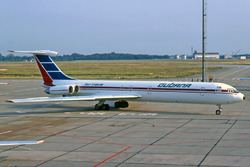Crew 11 Survivors 0 Date 3 September 1989 Injuries (nonfatal) 0 Operator Cubana de Aviación | Passengers 115 Fatalities 150 (24 on ground) Aircraft type Ilyushin Il-62M | |
 | ||
Similar Independent Air Flight 1851, Korean Air Flight 803, Olympic Aviation Flight 545, United Express Flight 2415, Tan‑Sahsa Flight 414 | ||
Cubana de Aviación Flight 9646 refers to a chartered Ilyushin Il-62M, registered CU-T1281 and operated by Cubana, that was due to operate a non-scheduled international Havana–Milan–Cologne passenger service and crashed on 3 September 1989, shortly after takeoff from José Martí International Airport, because of bad weather. All 126 occupants of the aircraft plus 24 people on the ground perished in the accident.
Contents
Accident
The aircraft took off in heavy rain and winds gusting to in the vicinity of 30–50 miles per hour (48–80 km/h). The crew retracted the flaps from their initial 30° position to 15°, in an attempt to gain speed, but this action reduced the possibility of the aircraft to gain lift. The plane climbed to about 53 metres (174 ft), where it was hit by downdraft currents that caused the airframe to strike the end of the runway, subsequently hitting a navigational facility and a small hill before crashing into a residential area, about a minute after takeoff. All 126 people on board —115 passengers, most of them Italian holidaymakers, and a crew of 11— perished in the accident; another 24 people lost their lives on the ground.
Cause
Investigators attributed the crash of Flight 9646 to the pilot's decision to fly after an abrupt deterioration in the meteorological conditions. The pilot underestimated the risks of taking off at the same time misjudging the aircraft's performance in poor weather conditions.
Aftermath
As of October 2013, the accident remains the deadliest one to occur on Cuban soil, followed by Aeroflot Flight 331.
